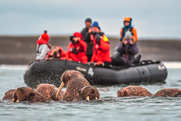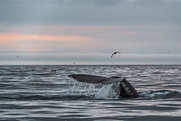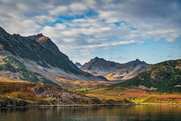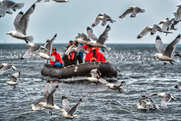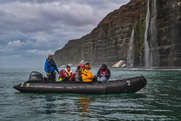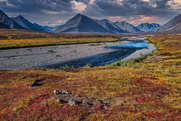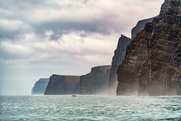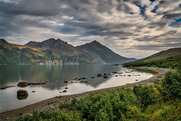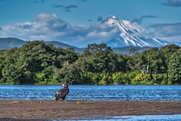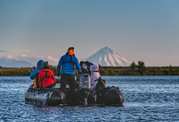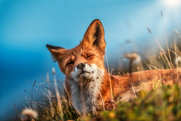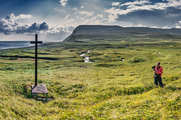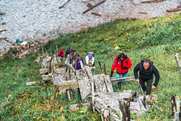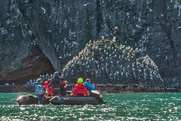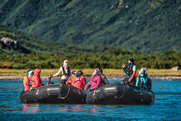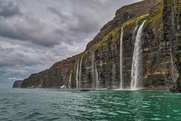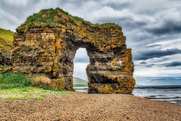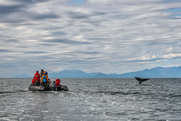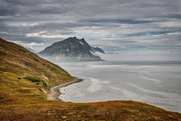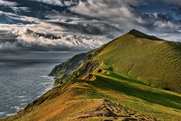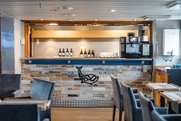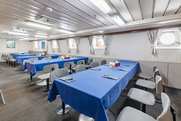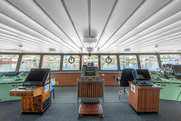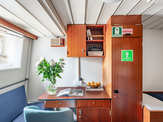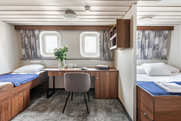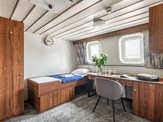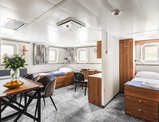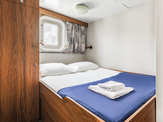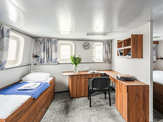
and adventures in Russia
_1495796542.jpg)
Chukotka, Kamchatka and the Commander Islands
Experiences you'll have
Cruise to the Russian Far East
You will explore the most hard-to-reach places of the Russian Far East on a comfortable expedition vessel. Sea trips on zodiac boats will alternate with walks on uninhabited islands accompanied by qualified guides and experts of the regions.
On board, you can enjoy lectures and movies about the nature, history, and culture of Kamchatka, Chukotka, and the Commander Islands
The reasons to join this cruise:
- exploring 3 unique regions in one journey: the Commander Islands, Kamchatka, and Chukotka
- watching whales, walruses, brown bears, and rare seabirds: puffins, red-faced cormorants, spoon-billed sandpipers, white-tailed eagle
- capturing the Arctic tundra, Kamchatka volcanoes, green fjords, and impregnable basalt cliffs
- visiting Meynypilgyno and Nikolskoye, remote villages where the locals have preserved the traditional way of life
- relaxing in hot springs in the middle of a picturesque lagoon, surrounded by cliffs, glaciers, and green slopes
The cost of the cruise depends on the selected cabin type. See details in the Accommodation section.
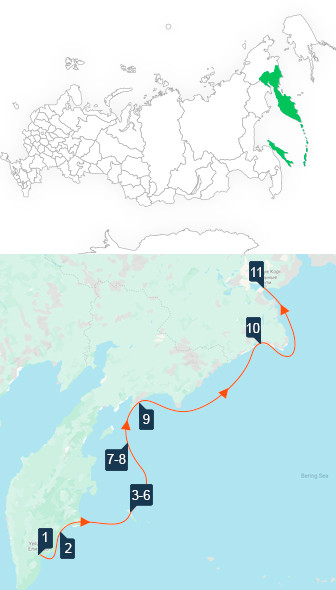
Itinerary
The cruise begins in Anadyr, which you will need to reach on your own. Please note that your return flight should depart from Petropavlovsk-Kamchatsky, where the cruise ends.
If you need assistance with purchasing tickets, please feel free to leave a comment in your application.
This is a general plan of the expedition, the route may vary depending on weather conditions.

Day 1 Boarding the Vessel in Anadyr
After arriving at Anadyr airport, a group transfer will take you to the port. You will board the vessel, settle into your cabins, and meet the ship’s crew. Then the Professor Khromov will set sail into open waters.
From the decks, you may spot beluga whales in the bay and seabirds soaring overhead. The dramatic Chukotka coastline stretches before you, with tundra, cliffs, and glaciers along the shore.
Days 2-3 Meynypilgyno Village and Cape Navarin
In the morning, the vessel passes along the western shore of Anadyr Bay to Navarin Cape, the windiest place in Russia. Millions of seabirds nest on the cliffs, and you may spot the rare white-tailed eagle. Coastal waters are home to whales, so keep your binoculars ready.
Later, you will reach Meynypilgyno Village (locals call it Maina). Here, the vessel will anchor, and expedition boats will take you to observe walrus rookeries and waterfalls cascading into the sea. Brown bears may also appear nearby.
There is a museum of Chukchi culture in the village. Nearby, a large population of critically endangered spoon-billed sandpipers spends the summer. A special incubator was built close to Maina, where international ornithologists breed chicks to release them into the wild.
Day 4 Bogoslova Island
The island is located between the entrances to the “Apostolic” bays. In the afternoon, you will arrive at Imatra Fjord, where the graves of whalers from the Aleut flotilla can be found, and enjoy a scenic hike to Lake Izumrudnoye (Emerald Lake)
Keep an eye out for brown bears, which are often seen along the shores of both bays and the island, feeding on local fish.
Day 5 Tintikun Lagoon
After a long sea crossing, Professor Khromov will arrive in the afternoon at another spectacular fjord — or rather, a lagoon, as it is separated from the sea by a sand spit. In the center of Tintikun Lagoon lies an island, and just a few meters from the water are hot springs (unfortunately, they are too hot for bathing).
Brown bears are common in this area, and if you’re lucky, you might even spot a wolverine, an animal so fierce that even bears avoid it.
Day 6 The Bering Sea
As the ship moves south, you will cross the vast Bering Sea. Whales and seabirds will accompany you along the way.
These two days are perfect for relaxing on deck, observing marine life, and sharing experiences with the expedition team.
Days 7-9 The Commander Islands
The ship will head southwest and stop early in the morning at the mouth of the Zhupanova River, one of Kamchatka’s best fishing spot.
For the next three days, you will explore the Commander Islands, discovered in 1741 by the expedition of Commander Vitus Bering, after whom they were named. You will visit all four islands of the national park, admiring landscapes filled with waterfalls, dunes, and rugged coastlines.
Your exploration begins with a visit to Nikolskoye, the only settlement on the Commanders. The local museum is one of the few places in the world where you can see the skeleton of the Steller’s sea cow, a species hunted to extinction in the 18th century. You can look for semiprecious stones on the beach and pick Arctic berries in the tundra.
You will also visit Commander Bay, where the graves of Vitus Bering and several members of his crew are located. The explorers, who reached the islands already sick and exhausted, did not survive the harsh winter. The island’s iconic rock arch — a striking sea stack — is named after Georg Steller, a member of Bering’s expedition.
The Commanders are home to an extraordinary diversity of marine mammals — unmatched anywhere else in Russia. At the Northwest Cape of Bering Island, you will see large colonies of Steller sea lions and northern fur seals, as well as sea otters and rare Stejneger’s beaked seals. Off the island’s southern coast, the waters host numerous cetaceans, including sperm whales, fin whales, humpback whales, northern minke whales, and orcas.
Expedition boats will take you to the bustling bird colonies of Toporkov and Kamen Ariy islands. Even if you’re not a bird enthusiast, the noise and energy of these rookeries will leave a strong impression. Here you can spot some of the Far East’s most striking seabirds — the tufted puffin, horned puffin, and red-faced cormorant. While walking on Toporkov Island, it’s important to step carefully to avoid damaging the puffins’ nesting burrows, which they dig in the ground.
Day 10 At Sea
If the weather permits, you will visit Cape Kekurny, where a permanent rookery of Steller sea lions can be seen. You may also spot sea otters and white-tailed eagles, and the waters here are home to a resident pod of fish-eating orcas.
Day 11 Arrival in Petropavlovsk-Kamchatsky
Today the ship will arrive in Petropavlovsk-Kamchatsky, located on the shores of Avacha Bay, the world’s largest natural harbor. Off the starboard side, you will see Kamchatka’s “home” volcanoes — Avachinsky, Koryaksky, and Kozelsky — as well as the Zhupanovskaya Sopka, a massif of four volcanoes
Upon disembarkation, a transfer will take you to the airport for your return flight home
Accommodation during the trip
Your voyage will take place aboard the expedition ice-class vessel Professor Khromov.
The ship is specially equipped for navigation in areas where larger vessels cannot pass. Its ice-class rating allows it to cruise safely in polar regions.
With just 46 passengers, Professor Khromov expeditions focus on getting you ashore as often—and for as long—as possible, with maximum safety and comfort.
Onboard facilities: bar, restaurant, lounge, library with themed literature, lecture hall, and sauna. Guests also enjoy access to the navigation bridge, as well as opportunities for wildlife and marine life viewing from open decks.
Rates depend on the selected cabin type:
- Triple cabin, shared bathroom – 10,165 USD per person
- Double, shared bathroom – 11,835 USD per person
- Superior – 14,956 USD per person
- Superior Plus – 17,207 USD per person
- Mini Suite – 23,523 USD per person
- Owner's Suite – 28,460 USD per person
The price is per person with double occupancy in a cabin. We reserve the right to adjust it due to significant fluctuations in the Rouble–US Dollar exchange rate.
When booking, a 70% prepayment is sufficient. The remaining 30% must be paid 120 days before the tour starts.
Cabins Description:
Triple (12 sq.m.) three lower and one upper berth, porthole, desk, closet, bedside tables, washbasin. The toilet and shower are on the deck.
Double (12 sq.m.): two lower bunks, sofa, porthole, desk, closet, bedside tables, washbasin. The toilet and shower are on the deck.
Superior (12 sq.m.): upper and lower berth, sofa, window, desk, closet, bedside tables, shower, toilet, and washbasin.
Superior Plus (12 sq.m.): two lower berths, sofa, window, desk, closet, bedside tables, shower, toilet, and washbasin.
Mini Suite (18 sq.m.): bedroom with double bed, living room with single bed, windows, TV, desk, closet, bedside tables, shower, toilet, and washbasin.
Owner's Suite (27 sq.m.): double bedroom, living room with single bed, sofa, TV, fridge, closet, windows on the bow and sides of the ship, shower, toilet, and washbasin.
Common questions
The group will be accompanied by an expedition team: tour leader, guides and lecturers.
The cost of the tour includes a full board: breakfast – buffet, lunch – main course, salad and dessert, dinner – main course, vegetables and dessert. An alcohol menu is available for dinner.
Chef can prepare meals according to your diet if you inform us in advance.
When choosing clothing and footwear, take into account the peculiarities of the Arctic region. Temperatures can drop below freezing at the northern points of the route. Sometimes there are no landings on the shore and the boats go along the shore.
Keep in mind that it can be very windy on the coast, this adds to the temperature effect. There will be splashing on the boat even in small waves, so clothing should be waterproof and windproof. The main heat loss occurs through the head, arms, and legs – pay maximum attention to these places. We recommend taking a camping seat with you. Don't forget about equipment: you need a waterproof case for shooting in rain and drizzle.
Clothing: warm pants, waterproof pants, thermal underwear, sweater, turtleneck, wool hat covering ears, balaclava/scarf, warm socks, waterproof hooded jacket. You can bring dressy clothes for the farewell party (heeled shoes are not recommended).
Footwear: trekking boots (not compulsory, but recommended for long walks on the shore). If you prefer trekking boots to rubber boots, you should bring them with you in your backpack and change them on the shore. Boots with grooved soles will give you the most stable footing. Rubber boots are also necessary, but they can be given free of charge on the first day of the cruise. It is important to bring warm insoles with you. If you plan to bring your boots, they should be mid-calf height or higher with thick ribbed non-slip soles. Some landings will require stepping into water up to 25 centimeters deep. It can also be quite slippery on the ice and on the shore. Make sure the boots fit comfortably with a wool sock. You will also need sandals, sneakers, or any other comfortable shoes for the ship, and flip-flops for the shower.
Other: a small backpack for landings (preferably waterproof), warm and waterproof gloves, sunglasses, cream (in windy weather preferably greasy nourishing), lipstick, binoculars, earplugs, swimsuit (for baths, hot springs, and optional bathing in the ocean), towel.
Documents: passport, airplane ticket, copy of insurance.
This journey requires medical insurance to cover emergency evacuation from inaccessible and remote locations. It is not included in the tour price and is paid additionally. We are ready to help with its registration, if necessary, leave a comment on the application form.
Jewel of the Russian Far East
- 15 September 2026










